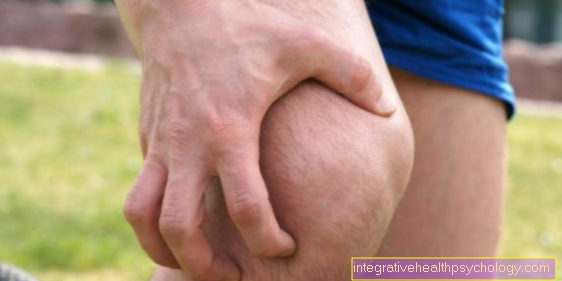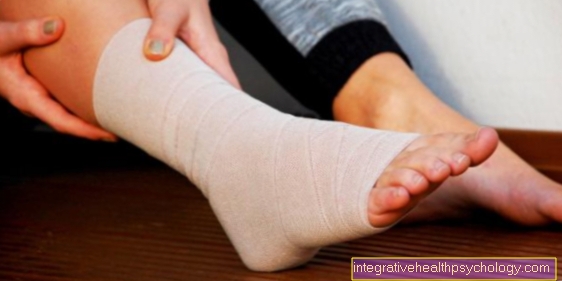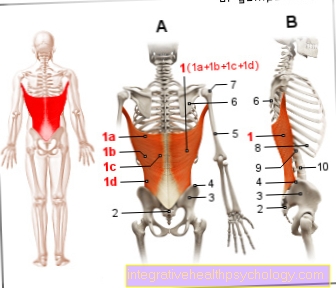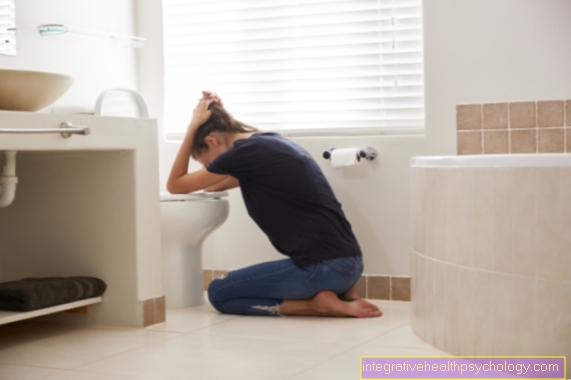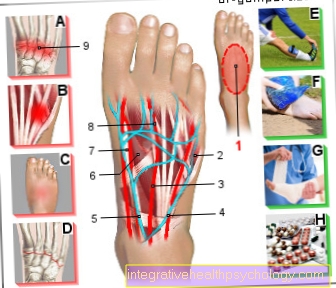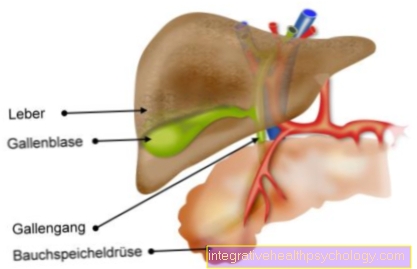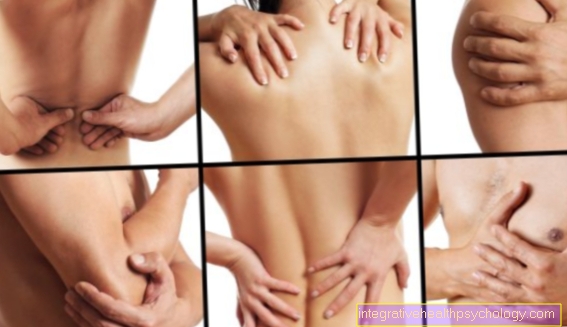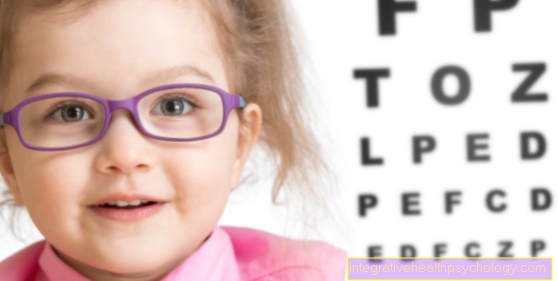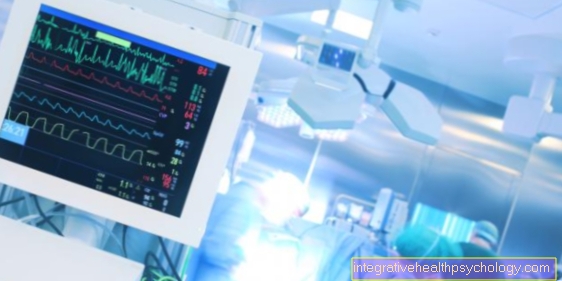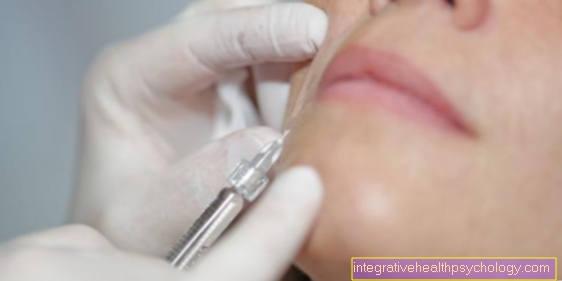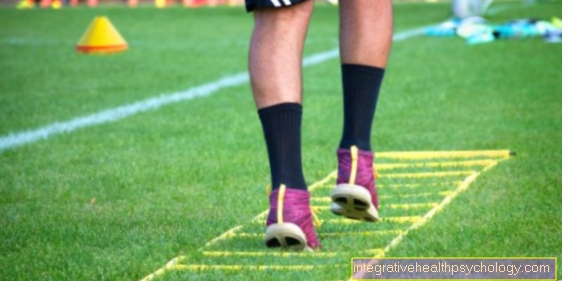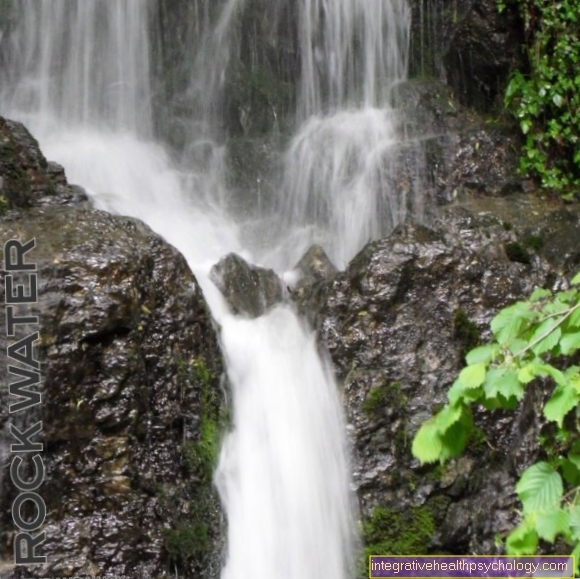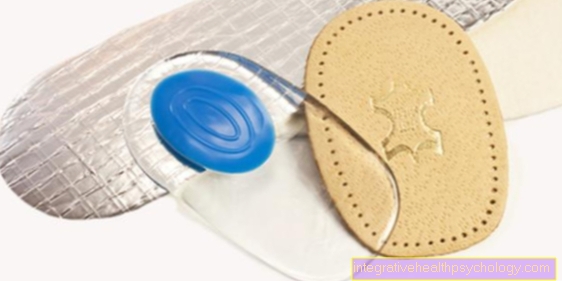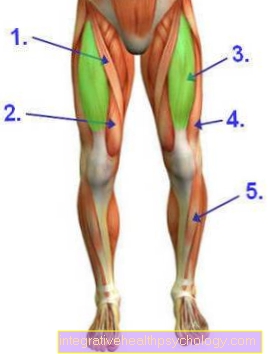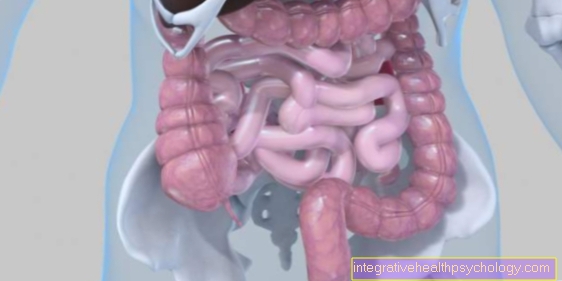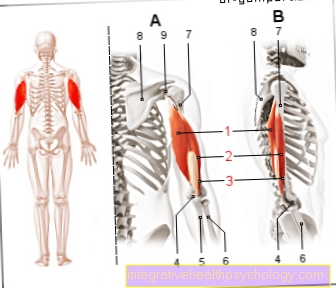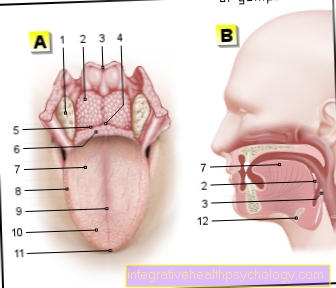Lumboischialgia
Synonyms
Sciatica, sciatica, back and leg pain, radiculopathy, nerve root pain, back pain
definition
Lumboischialgia is not a diagnosis of disease, but the description of a decisive and pioneering sign of the disease, the in the leg relaying back pain

Terminology
Lumboischialgie is made up of the following terms Low back pain = back pain in the field of Lumbar spine and Sciatica = leg pain transmitted via the sciatic nerve together.
- Lumbar spine pain
- Sciatic nerve
Appointment with a back specialist?

I would be happy to advise you!
Who am I?
My name is dr. Nicolas Gumpert. I am a specialist in orthopedics and the founder of .
Various television programs and print media report regularly about my work. On HR television you can see me every 6 weeks live on "Hallo Hessen".
But now enough is indicated ;-)
The spine is difficult to treat. On the one hand it is exposed to high mechanical loads, on the other hand it has great mobility.
The treatment of the spine (e.g. herniated disc, facet syndrome, foramen stenosis, etc.) therefore requires a lot of experience.
I focus on a wide variety of diseases of the spine.
The aim of any treatment is treatment without surgery.
Which therapy achieves the best results in the long term can only be determined after looking at all of the information (Examination, X-ray, ultrasound, MRI, etc.) be assessed.
You can find me in:
- Lumedis - your orthopedic surgeon
Kaiserstrasse 14
60311 Frankfurt am Main
Directly to the online appointment arrangement
Unfortunately, it is currently only possible to make an appointment with private health insurers. I hope for your understanding!
Further information about myself can be found at Dr. Nicolas Gumpert
Causes of Lumboischialgia
The most common cause of lumbar sciatica is protrusion of the intervertebral disc and thereby compression of the nerve root. A complete herniated disc (Disc prolapse) and a protruding disc (Protrusion) differentiated. Here, the intervertebral disc arches only slightly into the spinal canal and can compress the nerves there slightly, which then leads to nerve pain in the back.
The intervertebral discs themselves lie like "Shock absorber " between the individual vertebral bodies and can slip out of the intervertebral space and cause pain when bending forward or applying increased pressure. The reason for this is usually previously damaged or degenerated vertebral bodies due to long periods of heavy stress on the spine, old age or osteoporosis.
Such a herniated disc occurs most frequently in the lower lumbar vertebra area between L4 / 5 or L5 / S1, so it can occur in the coccyx.
When this herniated disc occurs in the sciatic nerve area, not only does it cause severe lower back pain, but it also causes pain and numbness in the legs. Muscular tension can also cause pain in the sense of lumbar sciatica due to poor posture. In this case, however, no neurological deficits should occur, and another therapy would also be indicated.
Blockages of the vertebral bodies or masses in the area of the spine can also cause severe pain. These can be bone tumors, but also harmless bony outgrowths (Osteophytes) act. These can grow from the vertebral bodies in the direction of the spinal canal and narrow it.
Nerve inflammation or a herpes zoster infection can also trigger pain in the form of lumbar sciatica. Inflammation of the surrounding tissue or abscesses can also trigger pain by irritating the nerves in the spinal canal.
Read more on the topic: Causes of Lumboischialgia
localization
Lumboischialgia on the right or left side
Lumboischialgia always arises from irritation of the sciatic nerve. In the majority of cases, the pain that is transmitted to the leg occurs either on the left or on the right.
Due to certain influences, the body is often asymmetrical and the structures on the right and left are also different in the spine. So it depends on various influences and coincidences whether the lumbar sciatica occurs on the left or right side.
In the most common cause of lumbar sciatica, the intervertebral disc bulges in a certain direction between the vertebral bodies. The direction also depends on the type of load and pressure. As a result, the intervertebral disc presses in a certain direction and on a sciatic nerve. It is very unlikely that both sciatic nerves are equally affected. The sciatic nerve for the leg to be treated emerges laterally from the vertebral bodies on the left and right.
Read about this too Pain in the left buttock
Bilateral lumbar sciatica
Bilateral lumbar sciatica is very rare. If it is nevertheless present, it is only in the rarest of cases equally pronounced. There is a high probability that bilateral lumbar sciatica is not caused by a herniated disc.
Arthritic and bony changes in the vertebral bodies are more likely. The narrowing of the spinal canal can also be a possible cause of bilateral lumbar sciatica. Here the nerve is already compressed before it emerges from the spine.
Finally, a fracture of a vertebral body is also a rare, potential cause of propagated lumbar pain. A central break in the vertebra can damage the exiting nerves on both sides.
However, since each leg has its own independent sciatic nerve, the overall likelihood of even, bilateral symptoms is very low.
The lumbar spine
The lumbar spine is the starting point for lumbar sciatica. From here, the pain radiates down the back of the thigh into the leg.
As a rule, minor pre-existing damage to the spine is the cause of the pain that is triggered.
Representation of a movement segment

Representation of a movement segment with two adjacent vertebral bodies and the exiting spinal cord nerve.
- Vertebral bodies
- Intervertebral disc
- Nerve root
- Anterior spinal cord nerve branch (Ramus ventralis)
- Posterior spinal nerve branch (Ramus dorsalis)
- Facet joint / vertebral joint
- Union of the spinal cord nerves to form the body nerves (e.g. sciatic nerve)
Diagnosis of lumbar sciatica

The symptoms described by the patient and the physical examination are indicative of whether a lumbar sciatica is present and further diagnostic measures are necessary.
The Lasegue sign (Lasegue test) can be regarded as a characteristic examination feature of lumbar sciatica. To do this, the patient is lying on his back. The painful leg is then slowly raised by the doctor in the extended position with flexion in the hip joint. The patient should not do anything, so be as relaxed as possible.
With root irritation symptoms, the patient will notice an intensification of pain in his lumbar sciatica at an early stage. The reason for this is the stretching of the sciatic nerve by lifting the leg, which in turn is transferred to the irritated nerve root. The Lasegue test is then referred to as positive. If the doctor wants to increase the stretching of the sciatic nerve, he pulls the toe of the raised leg towards the patient. The lumbar sciatica is further accentuated (Bragard test: positive).
The sign according to Lasegue is only positive in the case of a characteristic lumboischialgiform pain indication when the leg is raised up to about 45 °. If pain only occurs when the leg is lifted over it, the Lasegue test can no longer be defined as positive, because some of the other diseases mentioned above can also lead to such complaints and it is therefore no longer definitely leg pain caused by a spinal cord nerve root . In this case the Lasegue test is negative. Sometimes such an examination result is also referred to as a positive "pseudo-lasegue" test.
If the root pain is to be proven in imaging procedures, then magnetic resonance tomography is best suited for this (MRI of the lumbar spine). With it, the nerve roots of the Spinal cord and possibly Herniated discs be made visible.
therapy

Very different therapeutic approaches are suitable for the symptomatic therapy of lumbar sciatica. Symptomatic therapy is understood to be therapy based on symptoms. A really causal therapy, such as the removal of a herniated disc, does not initially take place.
Read more on the topic: Therapy of lumbar sciatica
storage
The lower back (lumbar spine) is relieved by a step position and the sciatic nerve is also relaxed by the bent legs.
physical therapy
The aim of physiotherapy for acute lumbar sciatica is to calm the mechanically irritated nerve root. For example, sling table treatment is suitable for this, in which the patient is brought into a weightless position and the nerve exit holes (neuroforamen) expand. The nerve root that is pressed in the area of the nerve exit holes is given the opportunity to recover.
General information on physiotherapy can also be found under our topic: Physiotherapy
Electrotherapy
The use of therapeutically effective forms of current (electrotherapy, electrostimulation) belongs to the field of physical therapy and is issued with the Medicines Ordinance for Physiotherapy. Different types of current have anti-inflammatory and analgesic effects. Drugs Classic anti-inflammatory and pain-relieving drugs are non-steroidal anti-inflammatory drugs (NSAIDs) and cortisone. Application in tablet form or as a cortisone injection is possible. The main goal is to reduce pain through anti-inflammatory measures at the nerve root.
Pregabalin (Lyrika ®) can also be used as an accompanying therapy for chronic lumbar sciatica. Lyrica ® has a pain-relieving effect on neuropathic pain (nerve pain) of various kinds.
Information about the drug Berlosin from our partner.
Local infiltrations
The most effective therapy for lumbar sciatica is through local, targeted infiltration of the affected nerve roots. This form of syringe therapy is also known as periradicular therapy (PRT). In order to apply infiltration precisely to the nerve root, an imaging procedure is necessary. The imaging support provided by computed tomography (CT) is particularly suitable for this. A mixture of a local anesthetic and cortisone is usually used as the injection content.
Infiltrations close to the spinal cord such as epidural infiltration or sacral infiltration (sacral blockade, sacral flooding) are also used with great success. Due to possible side effects, such as a brief feeling of weakness in the legs and the resulting risk of falling, these infiltrations are preferably carried out under inpatient control.
Further information is also available under our topic: Epidural Infiltration
When is cortisone necessary for the treatment of lumbar sciatica?
The administration of cortisone does not play a role in the primary therapy of lumbar sciatica.
Ideally, therapy consists of a combination of pain management through medication and physiotherapy. However, if this does not reduce the pain, further therapy methods must be considered. Physical therapy is an important form of therapy. Electrotherapy or the administration of cortisone can initially relieve pain and stop inflammation. Cortisone has strong anti-inflammatory effects.
Another therapy option that can be used after other therapies fail is local injection of cortisone and narcotics into the nerve root, which causes the referred pain. Under close observation in the CT, the mixture is injected into the nerve root and anesthetized it. It is not a causal, but merely symptomatic therapy, but it has achieved good results.
surgery
Is lumboischialgia due to the severity of the underlying condition, e.g. Due to a very large herniated disc, which cannot be treated conservatively enough, surgical therapeutic measures are used by removing the herniated disc (microsdiscectomy, endoscopic discectomy) and / or widening the nerve exit holes (decompression, foraminotomy).
Kinesio tape for the treatment of lumbar sciatica
In contrast to conventional rigid tape dressings, kinesio tapes are elastic tapes that are stuck onto the skin from the outside.
The elastic bandages do not affect movement in the joint. However, due to the light, external pulling effect, they make movements more conscious. As a result, more conscious, less jerky and gentler movements should be performed.
The kinesio tape is used for the therapy of muscle complaints but also for prevention in sports medicine. The kinesio tape can also encourage more conscious movements on the lower back and, if necessary, prevent disc problems.
Acupuncture for the treatment of lumbar sciatica
Acupuncture is an alternative medical treatment approach from traditional Chinese medicine. Disturbances in the balance of the body are corrected with pin pricks. The needles are placed on so-called “meridians” of the body by an experienced therapist in order to correct the imbalance there. Acupuncture is used in orthopedics in particular and is also used in the treatment of chronic back pain and lumbar sciatica that radiates into the legs.
The exact effect of acupuncture is controversial. Many treated patients describe a subjective improvement in symptoms. However, in the case of acute causes such as a herniated disc, it is important to first weigh up drug or surgical therapy. Acupuncture can then be used as a complementary therapy concept.
Differentiation between a herniated disc and a vertebral blockage
A vertebral blockage is a painful process in which two vertebrae that are lying on top of each other become jammed.The individual vertebrae have several joint surfaces and branches in order to guarantee stability of the spine, protection of the vertebral canal and flexibility in movement. Clumsy movements or jerky rotation can block these vertebral joints, which is often associated with muscular tension. This results in a violent, shooting pain, which is also known as "lumbago".
In contrast, a herniated disc is a disease of the intervertebral disc. This ruptures in a sudden movement, for example when lifting heavily, and the fluid in the core of the intervertebral disc escapes. Here, too, acute and stabbing pain can occur.
Lumboischialgia can occur as a result in both cases. Due to the vertebral blockage, the muscular tension can influence the exiting sciatic nerve. In the case of a herniated disc, the escaping fluid can push the nerve.
Differentiation between an SI joint blockade and lumbar sciatica
An SIJ block is a mechanical blockage of the sacroiliac joint. This is located in the lumbar region and connects the sacral vertebrae with the large hip vane. The joint is functionally severely restricted, but is heavily stressed when bending, sitting and lying down. A blockage in this area is very painful.
The cause of the blockage is muscular tension caused by incorrect movement. This can be triggered by heavy lifting, jerky movements, twisting the hips or the typical “step into the void”. The blockage can be released again with the help of certain exercises. This can also cause pain that radiates into the leg. One speaks of "pseudoradicular" pain.
There is a big difference between lumbar sciatica and SI joint blockade. Lumboischialgia affects the nerve root or the nerve itself. The pain can be tracked accordingly and precisely assigned to the nerve supply area. The pseudoradicular pain of the SI joint blockade cannot be tracked because there is no irritation of the nerve root. Nevertheless, radiating tingling and numbness down to the legs are described here.
Duration of lumbar sciatica
The duration of lumboischialgia varies greatly among those affected. Simple irritation of the nerves leads to the typical symptoms, but can subside within a few days to weeks.
Even with a herniated disc, the duration of the illness varies greatly. Herniated discs can heal within a few weeks, unfortunately in some cases they can also cause chronic pain for several months. If the sciatic nerve is involved, the pressure must be released as quickly as possible. On the other hand, the nerve can be damaged and cause chronic, long-term loss of sensitivity, tingling, and pain.
Prevention of lumbar sciatica
The prevention of complaints in the lumbar region and the associated sciatica should take place throughout life.
Nowadays, large proportions of adult people occasionally experience lower back pain. The reasons for this are a lack of exercise in everyday life, long periods of sedentary work, incorrect lifting and lack of muscle strength.
The most sensible prevention of lumbar sciatica consists of exercise, targeted muscle training of the lower back and gentler movements. Heavy lifting from the floor in particular is a dangerous trigger for disc discomfort. Whenever possible, lifting movements must always be made with the legs.
Lumboischialgia in pregnancy
Lumboischialgia is not uncommon during pregnancy. Often the symptoms are triggered by pregnancy and subside again after pregnancy. Here, too, a herniated disc may be the cause. Due to the increased weight load towards the end of pregnancy, the back is heavily stressed when lifting movements.
But pregnancy itself can also be the cause of lumbar sciatica. As the child grows, the pressure in the abdomen increases significantly. Surrounding organs can be displaced and put pressure on the sciatic nerve. The growing uterus itself can also press on the sciatic nerve, as the nerve runs directly under the gluteal muscles. Even if the pain subsides after pregnancy, it must also be treated during pregnancy, otherwise it can become chronic.
Read more on the topic: Lumboischialgia in pregnancy


